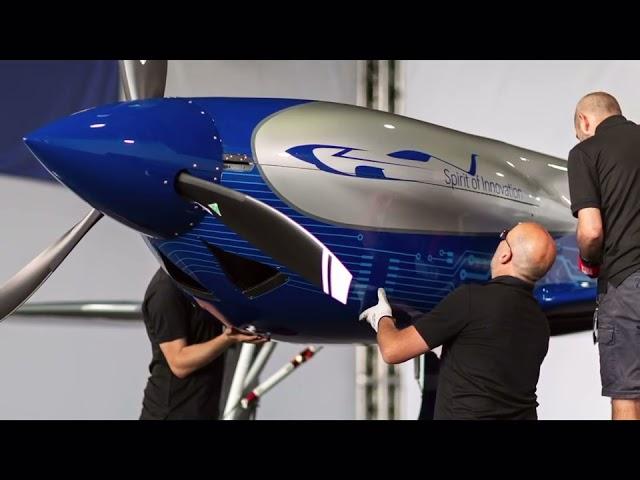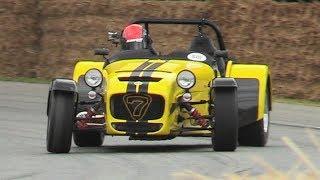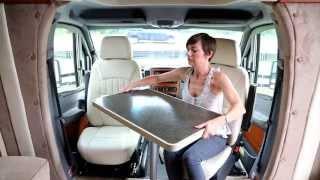
The World's Fastest Electric Airplane - RR
The World's Fastest Electric Airplane
THE SPIRIT OF INNOVATION
On November 16, 2021, an experimental aircraft called the ‘Spirit of Innovation’, designed by Rolls Royce, would record an average speed of just under 556 km/h or 345mph over a 3km span. The Spirit of Innovation is the world's fastest, all electric aircraft. It superseded the previous record set by the Siemens eAircraft Extra 330 LE Aerobatic aircraft in 2017 by over 213 km/h or 132 mph, and it also climbed over 60 seconds faster to 3000 meters or about 10,000 ft.
BUILDING THE AIRCRAFT
The Lycoming engine was replaced by three electric motors and the fuel tank by three battery packs. Combined, the battery packs, motors and control equipment were similar in weight to the existing power plant, however this fully electric system was now capable of outputting around 530hp continuously and almost 1000hp in bursts. By comparison, in a conventional aircraft, the overall weight is reduced as the fuel is used up. To compensate for this, the aircraft was converted to a single-seater to reduce weight further, though at the cost of moving the center of gravity slightly forward.
MOTOR
Designing the propulsion unit for the Spirit Of Innovation was also another major hurdle for the ACCEL team. Not only must the electric motor be compact and powerful, but also possess a high degree of reliability and the ability to tolerate failures, for aviation use. Because no single electric motor was commercially available that would meet these requirements, the team decided on a propulsion configuration composed of a stack of 3 YASA 750R axial flux electric motors coupled by a single shaft running through them. Using 3 of these motors in tandem not only met the power requirements of the ACCEL team but it also offered redundancy against motor failure.
While the entire triple motor system weighed just 111kg or about 244lbs, it was capable of generating around 750kw or 1000hp, though continuous total power was limited to around 210kw or about 280hp, due to thermal constraints.
COOLING
Unlike road going vehicles, aircraft require relatively larger amounts of continuous power simply to cruise. For an electric aircraft this creates safety concerns as the high wattage draw, combined with the density of the propulsion system’s packaging, generates significant amounts of heat. Within the battery pack, each individual cell was fitted with both voltage and temperature sensors. This robust sensor array not only drove the thermal management system, but also served as a safety mechanism, providing the pilot information on the health of the battery as well as alerting to potential failure conditions.
In the event of catastrophic battery failure, the thermally insulated containing structure is designed to be fireproof, making use of a purging mechanism that maintains an inert argon atmosphere within it.
FIRST FLIGHT
Over the next few weeks, around 30, 15 minute flights were conducted, with each gradually increasing flying speeds as the functionality of the propulsion system was validated. As speeds increased, Rolls-Royce had to make use of a Spitfire as the chase plane to keep up with the electric aircraft. While O’Dell described the aircraft as being not very different to fly than the existing aircraft he was familiar with, it’s electric propulsion system did present some unique characteristics. In between flights, the battery packs could be recharged individually within an hour, though this was primarily limited by the electrical infrastructure that the team operated from.
RESULTS
Unlike electric cars, high voltage batteries in aviation use are at higher risk for arcing from corona effect due to the lower air density at higher altitudes. Future electric aircraft designs may need to adopt a staged operating voltage system that can balance the risk of arcing with the aircraft’s size, power requirements and altitude. Additionally, electric aircraft subject their batteries to far more frequent full discharges than road electric vehicles, which drastically affect battery life.
#urbanairmobility #evtol #vtol #future #aircraft #aircraftdesign #pilot #pilots #flight #electricaircraft #uberair #concept #aviation #tech #investors #angelinvestor #advancedairmobility #aam #uam #electricaircraft #aviation #aviationlovers #vertical flight #propulsion #vectorthrust #vectorpropulsion #aerocar #aeronautics #aviacion #propulsion #aviones #aeronaves #vuelo #pilotos #R&D
THE SPIRIT OF INNOVATION
On November 16, 2021, an experimental aircraft called the ‘Spirit of Innovation’, designed by Rolls Royce, would record an average speed of just under 556 km/h or 345mph over a 3km span. The Spirit of Innovation is the world's fastest, all electric aircraft. It superseded the previous record set by the Siemens eAircraft Extra 330 LE Aerobatic aircraft in 2017 by over 213 km/h or 132 mph, and it also climbed over 60 seconds faster to 3000 meters or about 10,000 ft.
BUILDING THE AIRCRAFT
The Lycoming engine was replaced by three electric motors and the fuel tank by three battery packs. Combined, the battery packs, motors and control equipment were similar in weight to the existing power plant, however this fully electric system was now capable of outputting around 530hp continuously and almost 1000hp in bursts. By comparison, in a conventional aircraft, the overall weight is reduced as the fuel is used up. To compensate for this, the aircraft was converted to a single-seater to reduce weight further, though at the cost of moving the center of gravity slightly forward.
MOTOR
Designing the propulsion unit for the Spirit Of Innovation was also another major hurdle for the ACCEL team. Not only must the electric motor be compact and powerful, but also possess a high degree of reliability and the ability to tolerate failures, for aviation use. Because no single electric motor was commercially available that would meet these requirements, the team decided on a propulsion configuration composed of a stack of 3 YASA 750R axial flux electric motors coupled by a single shaft running through them. Using 3 of these motors in tandem not only met the power requirements of the ACCEL team but it also offered redundancy against motor failure.
While the entire triple motor system weighed just 111kg or about 244lbs, it was capable of generating around 750kw or 1000hp, though continuous total power was limited to around 210kw or about 280hp, due to thermal constraints.
COOLING
Unlike road going vehicles, aircraft require relatively larger amounts of continuous power simply to cruise. For an electric aircraft this creates safety concerns as the high wattage draw, combined with the density of the propulsion system’s packaging, generates significant amounts of heat. Within the battery pack, each individual cell was fitted with both voltage and temperature sensors. This robust sensor array not only drove the thermal management system, but also served as a safety mechanism, providing the pilot information on the health of the battery as well as alerting to potential failure conditions.
In the event of catastrophic battery failure, the thermally insulated containing structure is designed to be fireproof, making use of a purging mechanism that maintains an inert argon atmosphere within it.
FIRST FLIGHT
Over the next few weeks, around 30, 15 minute flights were conducted, with each gradually increasing flying speeds as the functionality of the propulsion system was validated. As speeds increased, Rolls-Royce had to make use of a Spitfire as the chase plane to keep up with the electric aircraft. While O’Dell described the aircraft as being not very different to fly than the existing aircraft he was familiar with, it’s electric propulsion system did present some unique characteristics. In between flights, the battery packs could be recharged individually within an hour, though this was primarily limited by the electrical infrastructure that the team operated from.
RESULTS
Unlike electric cars, high voltage batteries in aviation use are at higher risk for arcing from corona effect due to the lower air density at higher altitudes. Future electric aircraft designs may need to adopt a staged operating voltage system that can balance the risk of arcing with the aircraft’s size, power requirements and altitude. Additionally, electric aircraft subject their batteries to far more frequent full discharges than road electric vehicles, which drastically affect battery life.
#urbanairmobility #evtol #vtol #future #aircraft #aircraftdesign #pilot #pilots #flight #electricaircraft #uberair #concept #aviation #tech #investors #angelinvestor #advancedairmobility #aam #uam #electricaircraft #aviation #aviationlovers #vertical flight #propulsion #vectorthrust #vectorpropulsion #aerocar #aeronautics #aviacion #propulsion #aviones #aeronaves #vuelo #pilotos #R&D
Тэги:
#AAV #eVTOL #air_taxi #electric #UAM #urban_air_mobility #drone #personal_drone #vertical #EV #electric_vehicle #Tesla #Tesla_air #Tesla_fly #Tesla_sky #Tesla_of_the_skies #electric_aircraft #PAV #personal_air_taxi #personal_aerial_vehicle #flying_taxi #flying_car #tiltrotor #VTOL #vertical_take_off #electric_vertical_take_off_and_landing #UL #business_aviation #Airbus #electric_air_taxi #XTI #Beta_Technologies #air_race #Air_Race_E #Diamond_Aircraft #DA-40 #Orb #Nomad #TCab_Tech #subscaleКомментарии:
The World's Fastest Electric Airplane - RR
Electric Aviation Channel & Video Library
Our Top RV Picks Under 30 feet
Gone with the Wynns
धाडसी बकरी | Marathi goshti | Marathi Story | Marathi kahani |
Shinzoo TV - Marathi
Интервью для Torosstudio
Алексей Шаранин
Best Automatic Cars in India Under 15 lakhs
Rtvehiclezone


























